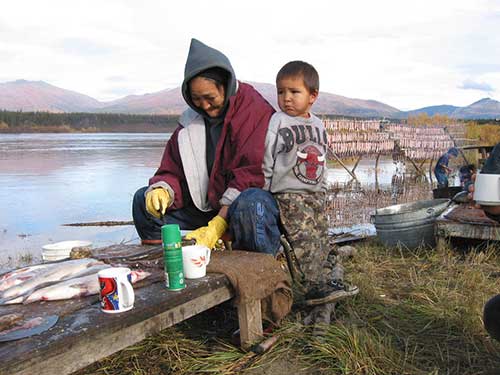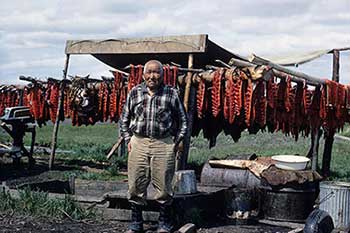Alaska Fish & Wildlife News
January 2014
Documenting the Harvest of Alaska’s Wild Food:
ADF&G’s Division of Subsistence

The ADF&G Division of Subsistence mission statement is to scientifically quantify, evaluate, and report information about customary and traditional uses of Alaska’s fish and wildlife resources. In our interactions with the public as Subsistence Resource Specialists (SRS) with the Division of Subsistence, we often find that citizens of Alaska are unclear about why the division exists and what services the division provides the citizens of Alaska. This two-part article will explain the legislative mandate of the division and will provide an overview of current projects and activities. In this first installment we will review the division’s Southern Region Program which includes Southwest, Southcentral, and Southeast Alaska and in the second installment division SRS Lisa Slayton will describe current projects in the division’s Northern Region Program, which includes the Western, Interior, and the Arctic regions of Alaska.
In 1978 the Alaska Legislature passed the state’s first subsistence statute, establishing subsistence as the priority use of Alaska’s fish and wildlife. At the time, the legislature recognized the need for basic information about subsistence uses --who, what, when, where, how, and how much -- to assist the Board of Fisheries and the Board of Game to develop regulations providing subsistence harvest opportunities consistent with sustained yield management. To address this information need, the 1978 law created a research unit within ADF&G called the “section of subsistence hunting and fishing,” that became the Division of Subsistence in 1981. The law directs the division to “compile existing data and conduct studies to gather information, including data from subsistence users, on all aspects of the role of subsistence hunting and fishing in the lives of the residents of the state.” The division’s other statutory responsibilities include assisting the boards in identifying customary and traditional uses of wild resources, and providing data for the boards to establish the amounts reasonably necessary for subsistence. Division findings are also used by agencies, other organizations, and the public.
Field Research

In order to accomplish these tasks the division employs SRS and fish and wildlife technicians who conduct field research, researchers who produce maps of subsistence use areas across the state, research analysts and program technicians who enter and analyze field data and maintain databases, publication specialists who edit and format the division’s Technical Paper Series, graduate and college interns in the social sciences, administrative staff, two regional program managers, a statewide program manager, also referred to as the research director, an assistant director, a deputy director, and a Governor appointed division director. The division’s Southern Region Program has a staff of 15 social scientists and graduate interns, with offices in Anchorage, Douglas and Dillingham. Currently the southern region maintains 28 active research projects.
The division uses social science research methods to conduct research across the state, including household harvest surveys, resource use mapping, ethnographic interviews, and participant observation. Division projects often employ a combination of these methods. Division research is either focused on a particular stock of fish or game population identified by resource managers or users, or is comprehensive documenting all wild resources harvested and used by a community. Comprehensive harvest surveys provide the division with detailed data regarding a community’s total harvest and use of wild foods, harvest practices, sharing of wild resources, harvest locations, changes in abundance and harvest of resources, as well as comprehensive demographic information. All surveys, species specific and comprehensive, contain sections that capture household food security, environmental changes, and opinions regarding resource health and regulations. Data collected during the survey are published at the community level, describing the characteristics of the average household in a community, while maintaining the anonymity of participants in a survey.

At present the divisions’ flagship comprehensive study is the ongoing Index Community Project, which monitors harvests of wild resources in all areas of the state. Currently the project is filling in data gaps throughout the State of Alaska by updating comprehensive harvest data. Following this an analysis will be conducted to identify key index communities to be monitored on a more consistent basis that will identify trends at the regional level.
During a research planning workshop in 2008, the Index Project was crafted because of the large number of communities in rural Alaska and the high cost of conducting research, which makes it difficult to update comprehensive data for most communities on a regular basis, due to the limited capacity of the division’s small research team. Data gaps in Western Alaska were first identified and surveys conducted in this area. Recent efforts include data gaps in Southeast Alaska and in 2013, five communities in Southeast Alaska – Hoonah, Angoon, Whale Pass, Hydaburg, and Haines – were updated by the division’s southern region.
Sitka is planned for 2014 and in 2015 the research focus will move to the Alaska Peninsula. Additional data gaps have been filled by special projects, usually identified as part of efforts to provide data for development projects or federal data needs. One project to fill in data gaps is the Copper Basin Harvest Assessment, a multi-year project in cooperation with Wrangell-St. Elias National Park and Preserve to document wild resource use and economic activities of residents of Alaska’s Copper River Basin. The Susitna-Watana Hydroelectric Project is also a comprehensive, multi-year project, contracted by the Alaska Energy Authority to document wild resources harvests in communities potentially affected by the proposed Susitna-Watana dam, located at the headwaters of the Susitna River just south of the Denali Highway.
Home Surveys

Comprehensive surveys are not an easy task for anyone involved, however, they are often enjoyable for Alaska residents who like to share their experiences with researchers. When administering a survey a researcher is accompanied by a local research assistant (a resident of the community) going door to door hoping people will graciously participate. Comprehensive surveys can be up to 30 pages in length and encompass the harvest practices, uses and sharing of every possible wild resource available in the area. Surveys are tailored to the region as well as to the specific goals of the project. When people kindly invite researchers into their homes to do a survey they often are giving at the very least a half an hour of their time. In most small communities there is a very low refusal rate, particularly in communities where there are other projects that are ongoing, or have been completed in recent years, as residents are aware of the value of the data. Nevertheless, researchers always appreciate being invited into resident’s homes to learn about the subsistence way of life in all its’ complexity. Ultimately, we are able to accomplishment the division’s mission because of the interest and the participation of the citizens of Alaska.
As with the Index Project, the State of Alaska provides the ADF&G Division of Subsistence with general fund each year to carry out comprehensive research in communities where recent comprehensive data is deemed necessary. Additional research is conducted to provide data for specific agency and development project needs. Besides the data needs described above residents and ADF&G staff in other divisions also identify projects that often coincide with data needs for proposals put before the Alaska Boards of Fisheries and Game. The division often works several years out from an upcoming board meeting to ensure that data will be available for proposals before the boards. When a community presents concerns, division researchers attempt to address them by applying for funding from state, federal or nonprofit research funders. Currently, the division’s Southern Region has many of these species and topic specific research projects. They range in focus from local knowledge of harbor seal in Iliamna Lake, wolf harvests on Prince of Wales Island, walrus hunting practices in Bristol Bay, to migratory sea bird harvests on St. Lawrence Island. The division also has several ongoing projects investigating harvest practices and local knowledge of Chinook salmon as part of the Governor’s Chinook Salmon Initiative. Fisheries are often a major research focus by the division and the Southern Region is currently conducting salmon specific research in communities on Kodiak Island, the Alaska Peninsula, and throughout southeast Alaska with funding provided by various funding agencies.

The data collected from all projects are published in the division’s technical paper series, made public on the division’s webpage and used in management forums. Comprehensive and resource specific research keep the southern division staff busy throughout the year. The Division of Subsistence’s Southern Region is consistently busy with activities that accomplish the mission statement and honor the obligations to the residents of Alaska. We encourage all interested readers to visit the ADF&G website www.subsistence.adfg.state.ak.us and the online Community Subsistence Information System http://www.adfg.alaska.gov/sb/CSIS/ for further information.
Subscribe to be notified about new issues
Receive a monthly notice about new issues and articles.
